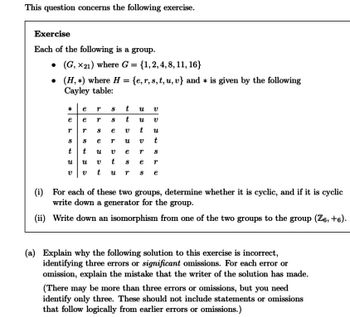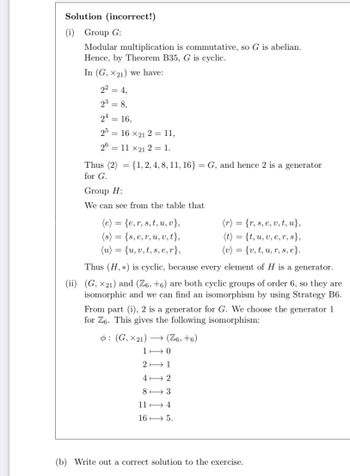
Advanced Engineering Mathematics
10th Edition
ISBN: 9780470458365
Author: Erwin Kreyszig
Publisher: Wiley, John & Sons, Incorporated
expand_more
expand_more
format_list_bulleted
Question
The I,I,iii within the exercise are not required as it is an example. A and B are required pleas

Transcribed Image Text:This question concerns the following exercise.
Exercise
Each of the following is a group.
. (G, X21) where G = {1, 2, 4, 8, 11, 16}
. (H,*) where H = {e, r, s, t, u, v} and is given by the following
Cayley table:
*
e T
e
T
T
S
S
e
t t
U
u
u
V
V
V t
e
T
s
S
S
e
T
5
t U V
t
U
V
V t
U
U V
t
e T
S
S e T
se
t
u T
(i) For each of these two groups, determine whether it is cyclic, and if it is cyclic
write down a generator for the group.
(ii) Write down an isomorphism from one of the two groups to the group (Z6, +6).
(a) Explain why the following solution to this exercise is incorrect,
identifying three errors or significant omissions. For each error or
omission, explain the mistake that the writer of the solution has made.
(There may be more than three errors or omissions, but you need
identify only three. These should not include statements or omissions
that follow logically from earlier errors or omissions.)

Transcribed Image Text:Solution (incorrect!)
(i) Group G:
Modular multiplication is commutative, so G is abelian.
Hence, by Theorem B35, G is cyclic.
In (G, X21) we have:
22 =
2³ = 8,
4,
24 = 16,
25
16 ×21 2 = 11,
26 11 X21 2 = 1.
Thus (2) = {1, 2, 4, 8, 11, 16} = G, and hence 2 is a generator
for G.
Group H:
We can see from the table that
(e) = {e, r, s, t, u, v},
(s) = {s, e,r, u, v, t},
(u) = {u, v,t, s, e, r},
Thus (H, *) is cyclic, because every element of H is a generator.
(ii) (G, X21) and (Z6, +6) are both cyclic groups of order 6, so they are
isomorphic and we can find an isomorphism by using Strategy B6.
From part (i), 2 is a generator for G. We choose the generator 1
for Z6. This gives the following isomorphism:
: (G, X21)→→ (Z6, +6)
1 0
(r) = {r, s, e, v, t, u},
(t) = {t, u, v, e, r, s},
(v) = {v, t, u, r, s, e}.
21
412
83
114
165.
(b) Write out a correct solution to the exercise.
Expert Solution
This question has been solved!
Explore an expertly crafted, step-by-step solution for a thorough understanding of key concepts.
Step by stepSolved in 4 steps with 4 images

Knowledge Booster
Similar questions
- Consider Anxp and Bmxp. Which of the following is NOT CORRECT? (more than 1 answer is possible) Select one or more: O a. O b. O d. U e. f. A x B = A X B = A + B = B Cnxm BX A Fnxm X A = Dnxm A B X BT = XAT Gnxm = Em mxnarrow_forwardWhich of these gives a general solution to d -1 dt 2 -1 18arrow_forwardHelparrow_forward
- Answer correctly and read the questions corretly, take your time do not rush, this is all one quesiton if done correclty and organized I will write a very nice review about you! Start of question rest in the images too large to fit all into images: Suppose you are a dolphin trainer at SeaWorld. You teach the dolphins by rewarding them with fish treats after each successful attempt at a new trick. The following table lists the dolphins, the number of treats per success given to each, and the average number of attempts necessary for each to learn to perform the tricks.arrow_forwardA parent downloads an app that allows him to monitor the amount of screen time his child is using on the phone. The child claims that she is only using 1 hour per day on the phone on average, but the app, over the course of 47 days, finds that the child used an average of 1.2 hours per day. The parent wants to know if the child is using an average of 1 hour per day for all days of use. a) The 1.2 is a/an: variable population parameter sample statistic observational unit b) The sample size is: 1 47 1.2 c) Each day is a/an: population parameter observational unit variable sample statisticarrow_forwardVa e3 3. Is the walk v1ejv2e2V4e3U5 e3 V4E4V3€5 V1 an Euler path, circuit or neither? O Neither O Circuit O Path Question 4 tv APR 21 MacBook Airarrow_forward
- Sole it clearly please.I need it as soon as possible. part b onlyarrow_forwardA die is rolled two times Provide a list of all the possible outcomes of the two rolls in this form: the result from the first roll and results from the second roll.The answer needs to be done using R which I am confused on how to doarrow_forwardGiven u =(-12,-5) and v=(3,9), what is proj,u?arrow_forward
arrow_back_ios
arrow_forward_ios
Recommended textbooks for you
 Advanced Engineering MathematicsAdvanced MathISBN:9780470458365Author:Erwin KreyszigPublisher:Wiley, John & Sons, Incorporated
Advanced Engineering MathematicsAdvanced MathISBN:9780470458365Author:Erwin KreyszigPublisher:Wiley, John & Sons, Incorporated Numerical Methods for EngineersAdvanced MathISBN:9780073397924Author:Steven C. Chapra Dr., Raymond P. CanalePublisher:McGraw-Hill Education
Numerical Methods for EngineersAdvanced MathISBN:9780073397924Author:Steven C. Chapra Dr., Raymond P. CanalePublisher:McGraw-Hill Education Introductory Mathematics for Engineering Applicat...Advanced MathISBN:9781118141809Author:Nathan KlingbeilPublisher:WILEY
Introductory Mathematics for Engineering Applicat...Advanced MathISBN:9781118141809Author:Nathan KlingbeilPublisher:WILEY Mathematics For Machine TechnologyAdvanced MathISBN:9781337798310Author:Peterson, John.Publisher:Cengage Learning,
Mathematics For Machine TechnologyAdvanced MathISBN:9781337798310Author:Peterson, John.Publisher:Cengage Learning,


Advanced Engineering Mathematics
Advanced Math
ISBN:9780470458365
Author:Erwin Kreyszig
Publisher:Wiley, John & Sons, Incorporated

Numerical Methods for Engineers
Advanced Math
ISBN:9780073397924
Author:Steven C. Chapra Dr., Raymond P. Canale
Publisher:McGraw-Hill Education

Introductory Mathematics for Engineering Applicat...
Advanced Math
ISBN:9781118141809
Author:Nathan Klingbeil
Publisher:WILEY

Mathematics For Machine Technology
Advanced Math
ISBN:9781337798310
Author:Peterson, John.
Publisher:Cengage Learning,

